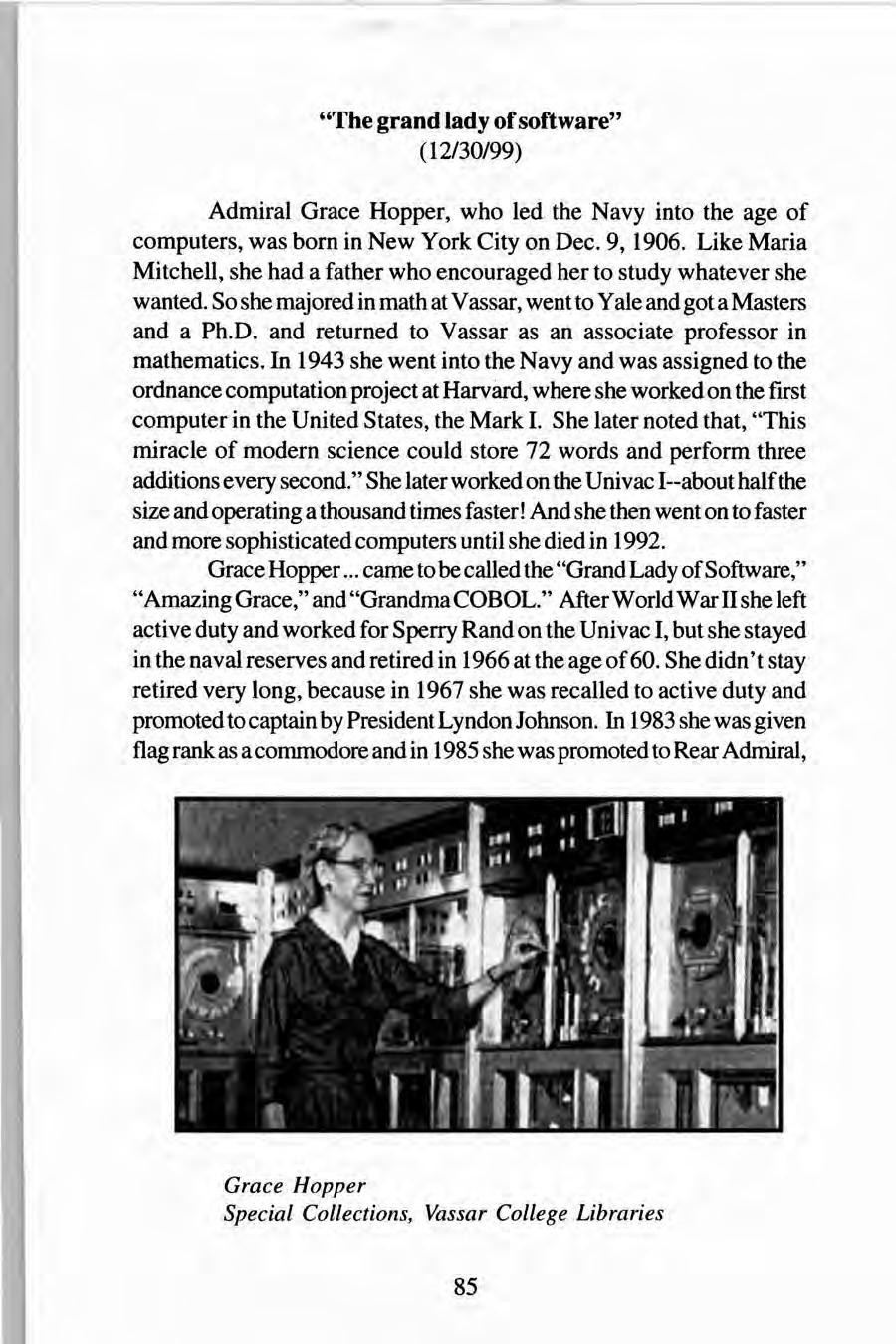
15 minute read
A Woman Who Made a Difference, Mary Lucy Ham Alley
A WOMANWHOMADEADIFFERENCE
By Ruth Hogan
Ruth Hogan presented this paper in October 1997 at the Wednesday Club, a literary group celebrating its 100th year. A graduate of Arlington High School and Vassar Brothers Hospital School of Nursing, Mrs. Hogan was a school nurse in the Arlington School District for 26 years. She and her husband, Robert, married fifty-five years, live in Poughquag. They have one son and three grandchildren.
Mary Lucy Ham Alley
Without a doubt there have been countless women through the ages who have had extensive influence both on their contemporaries and on subsequent generations. They made a difference. A number of women have had an influence on my life. Certainly my grade school teacher, Dorothy Howell, later Dorothy Hitsman, had a major
impact. She taught grades 1 to 8 in a one-room school in Fishkill Plains. She was a highly intelligent woman with the patience of Job, a dedicated teacher who truly inspired her students. Other influential women were those nursing teacher/supervisors at Vassar Brothers Hospital. Student nurses ate, slept, studied, and worked under the watchful eyes of Rachael Mccrimmon, Sara Sweet, and Edith Lindberg. They surely made a difference in my life. Great as these women were, however, they were second to one other, for it was Mary who was my primary mentor, advisor, and my encouragement throughout my life. Mary was born in the fall of 1893, the oldest of six living children. Her father at one time had been a school teacher but at the time of Mary's birth he was a farmer, by circumstance and not by choice. His twin brothers had migrated to South Dakota leaving him on the family farm, which supported him, his wife and children, as well as his aging parents. Mary's mother, typical of her day, had not worked outside the home since completing her studies at Linden Hall Finishing School in Poughkeepsie. She was a wife and mother, a homemaker. Mary loved the farm. She enjoyed the animals and the fields where she could walk to see flowers, plants, and birds. She was very fond of her siblings and often found herself their sitter. Mary loved her grandparents, both those who lived under the same roof and those who lived on Parkins Lane, a short distance from the farm. She attended Sunday School and church but she liked school best and was eager to learn. Her spare time was spent learning to sew and cook; most of all she loved to read and spent many hours lost in stories found in the books which filled her home. Mary's school was near her home, just down the road a few hundred feet. It was a one-room school housing a couple of dozen students in grades 1 through 8. They were neighbors and all walked to school each day; most also walked home for lunch. Mary's very good friend, Rebe Vincent, lived nearby so they often walked together as well as played together at recess. The road over which they traveled to school, to church, or wherever they went, was a dirt road. Dirt was an idealistic term, according to Mary, since "it was more often mud, liberally laced with horse droppings." Walking in long dresses and leather slippers amid such a mess rendered the clothing messy and fragrant Of course, no one noticed since all had a similar odor. Mary's home, built by her paternal grandfather, was a spacious
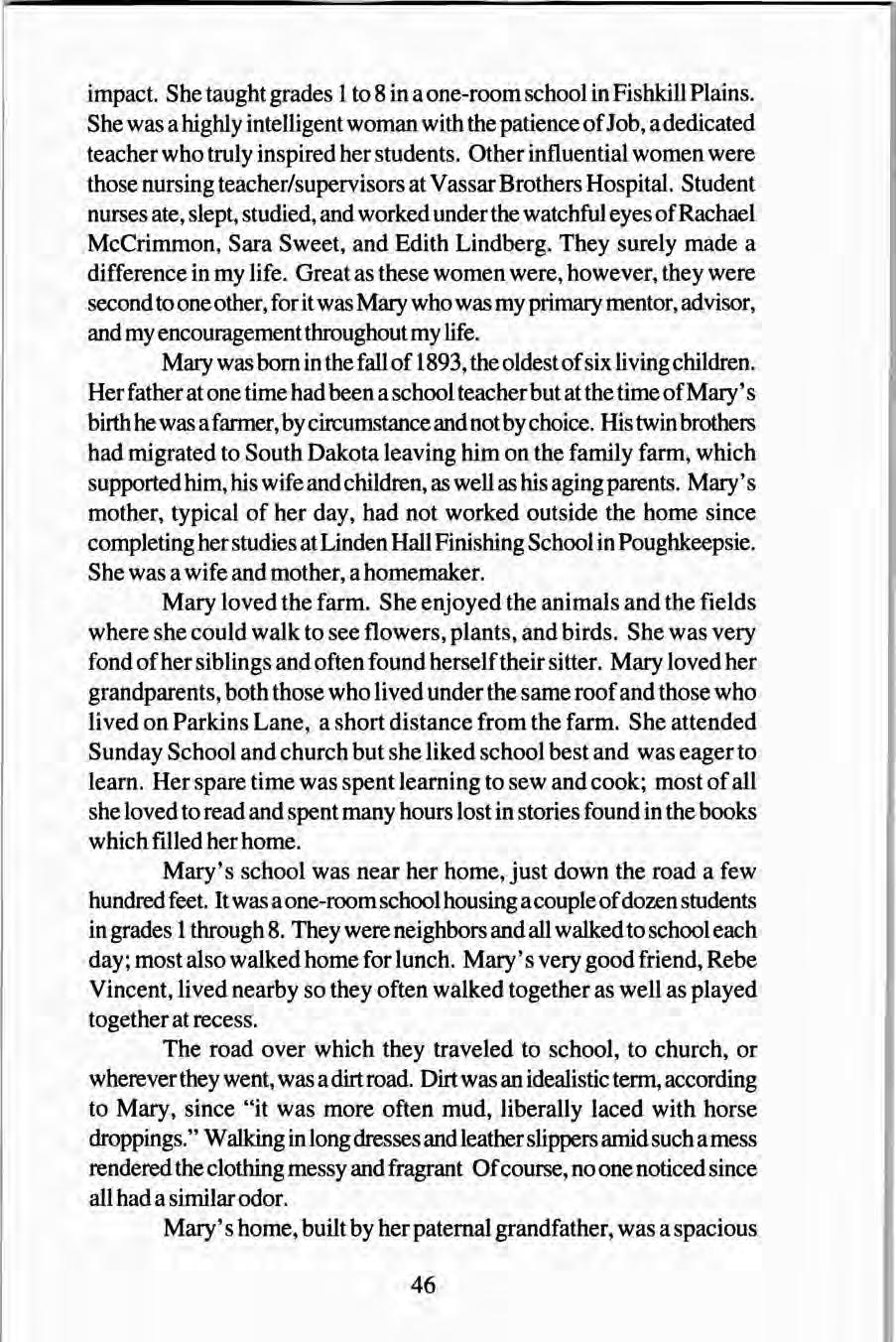
two-story farm house situated on an intersection in the road at North Clove. A brook ran through the dooryard and there was a spring house on the brook. It was used primarily to cool cans of milk awaiting market. Often, however, cured hams hung in the cool spring house or a watermelon floated in the water. A root cellar behind the house kept the potatoes, cabbages, carrots, apples and beets from freezing during the cold weather. Upon completion of her elementary schooling Mary wanted to attend high school. The nearest high school, however, was in Millbrook, too far for daily travel. Mary, therefore, rode the milk train to Millbrook each Monday morning, boarded in the village during the week and returned home to the Clove on Friday afternoons. She helped with the cooking and serving meals to help pay her board. All of this was worth the effort, for she was able to attend school and enjoy her studies and peers. She excelled in her classes and finished with one of the highest grade averages in her graduating class. Following graduation in 1912, Mary returned to the Clove where she was hired as the local school teacher. She taught for two years but soon concluded that was plenty. Certainly contributing to her decision were the facts that she was teaching her siblings, living at home where she was expected to help with household chores, and help care for her aging grandparents as well as prepare lessons and correct papers. The role of the one-room school teacher of that day included various janitorial duties before and after school hours as well as building a fire to heat the room, emptying ashes and sweeping the school room. It was not the life on which Mary was ready to settle. She was young and eager to explore new horizons. In Poughkeepsie, Eastman Gaines College offered courses for young ladies. There was a great demand for those proficient in typing, shorthand, bookkeeping, and filing skills. Mary enrolled and while there was encouraged by one of her instructors to take the Ci vii Service test for government employment. Her success gained her an appointment in Washington, D.C. during World War I, working in the Executive General's Office of the Department of War. She was far from home but not alone, for she found many other young women in like circumstances. Again Mary used her experience to get work serving meals in her Washington boarding house to defray some of her board. Despite a great outbreak of flu, Mary thoroughly enjoyed her experiences in Washington. Following the Armistice, Mary's position was eliminated. She
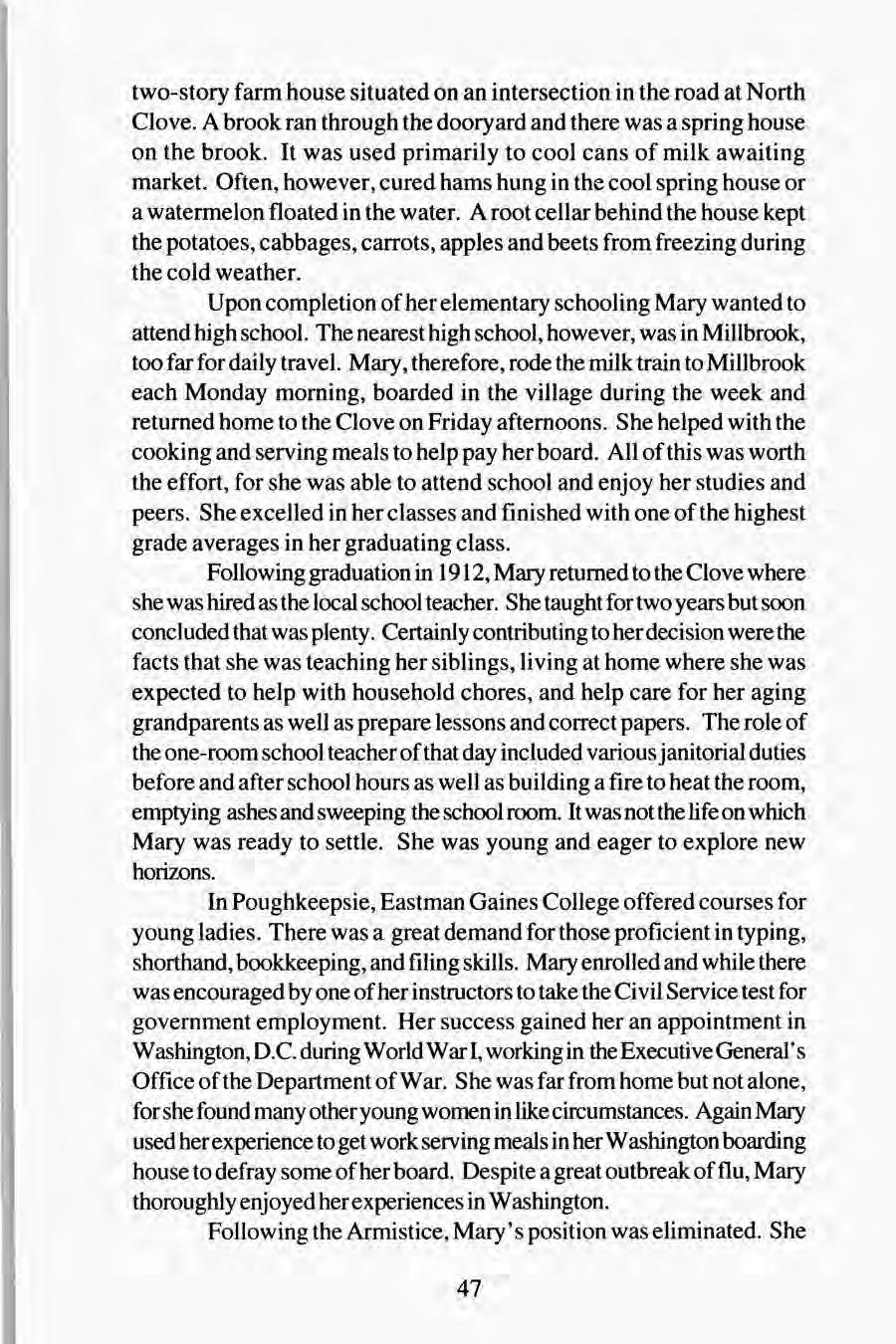
returned once again to the Clove but not to stay, for she had met a young man from Fishkill Plains and they planned to be married. Bert was a dairy farmer, the youngest of six children, who, with the exception of himself, had left home. As a single man, he was operating the family farm and living at home with his parents. In the spring of 1920, Bert and Mary were married at her home in the Clove, and they set up housekeeping in one half of the farmhouse on Hillside Lake Road. Mary was very close to her mother-in-law whom she both loved and respected. In July 1921 Mary gave birth to a boy. She had been under the professional care of an obstetrician in Poughkeepsie and had spent her "confinement" in a maternity hospital there. The baby was seen at regular intervals by a pediatrician in Poughkeepsie too, yet he failed to thrive. On a cold January day when traveling to Poughkeepsie was an impossibility, the baby became gravely ill. Bert hastened to Hopewell to get Dr. Coburn, the local doctor. When he entered the home, he recognized the distinctive symptoms of the baby and instructed Bert and Mary to get ready to go to New York City with the baby. Although this pathetic group made it to the city, the baby died before surgery. He had succumbed to pyloric stenosis, correctly diagnosed by Dr. Coburn but completely missed by the specialists in Poughkeepsie. From that day on, there was no physician to care for Mary or her family but Dr. Coburn. This was true until his death. During the same winter of 1922, for the first time, all dairy cattle were required to undergo tests for tuberculosis. Bert's entire herd reacted and were destined for slaughter, leaving Bert and Mary with no income. Mary once remarked, "the chickens and the food from the root cellar saved us from starving that winter." They survived and Bert rebuilt his herd; however, his mother's health was failing and Mary was pregnant again. A baby girl was born in January 1923 and another daughter in July 1924. By that time Bert's back pains made it impossible for him to continue the hard labor of farming. Following the death of his mother in the spring of 1925, Mary and Bert moved to the village of Fishkill Plains where they bought a small bungalow which had been built by Ernest Horton. They also operated a general store just two doors down from their home. It was possible for Mary to take her two girls to the store with her. She would place the baby in the sugar bin where she would sleep, but the toddler was much more challenging. Bert was rarely at the store, for he had launched a new vocation in cattle dealing. He traveled far and wide buying, trading,

and selling cows and horses. By the time Mary's third daughter was born in 1926, the store was proving too much for her to handle, so they sold the business and Bert became the sole provider for his growing family. Bert was the breadwinner but it was Mary who held it all together. Mary often remarked that at the time of their marriage Bert was 34 and she was 27. They wanted several children, so there was no time to waste. After three girls, two boys were born just two years apart. By 1930 Mary had delivered six children in just ten years, busy years indeed.
Soon after her son Jack's birth, the banks failed and America was plunged into the Great Depression. The country was devastated as factories went out of business and able-bodied men were without work. Although many were hungry, there was never a hungry day in Mary's family, nor was anyone, friend or stranger, ever turned away hungry. The many hobos who disembarked from the train near Mary's home were always fed. After eating they were often allowed to bed down in the warm barn during the night. There was always plenty of food in the house, but it did not come without hours of hard work. Each year Bert planted a large vegetable garden, raised hogs for butchering, had a chicken coop filled with Rhode Island Reds, good layers and good for the pot. He also raised Muscovy ducks, also good to eat. Mary preserved food for the winter by canning tomatoes, corn, peas, green beans, beets, strawberries, pears, peaches, jams and jellies, as well as several kinds of pickles. My mouth waters yet when I recall those delicious pickled pears and the watermelon pickles. All of this was done with the aid of the kerosene-burning oil stove. Since the vegetable garden produced more than even this large family could consume, Mary maintained a vegetable stand in front of her house. She sold fresh produce to neighbors and friends, or to anyone desiring freshly-picked produce. Monies from these sales provided Mary with funds for school clothes, as well as for birthday gifts and Christmas presents. She pored over the Montgomery Ward and Sears & Roebuck catalogs. Mary's days were long and busy, leaving little time to herself, certainly little time to read. Yet her love of books and her love of reading never waned. Whenever she went into Poughkeepsie, ~he frequented the lending library at Luckey Platt & Co. They would loan books to people living outside of the city. In the mid-1930s, Augustus Bush donated several boxes of books. Mr. Bush, a resident of Fishkill Plains, was the warden
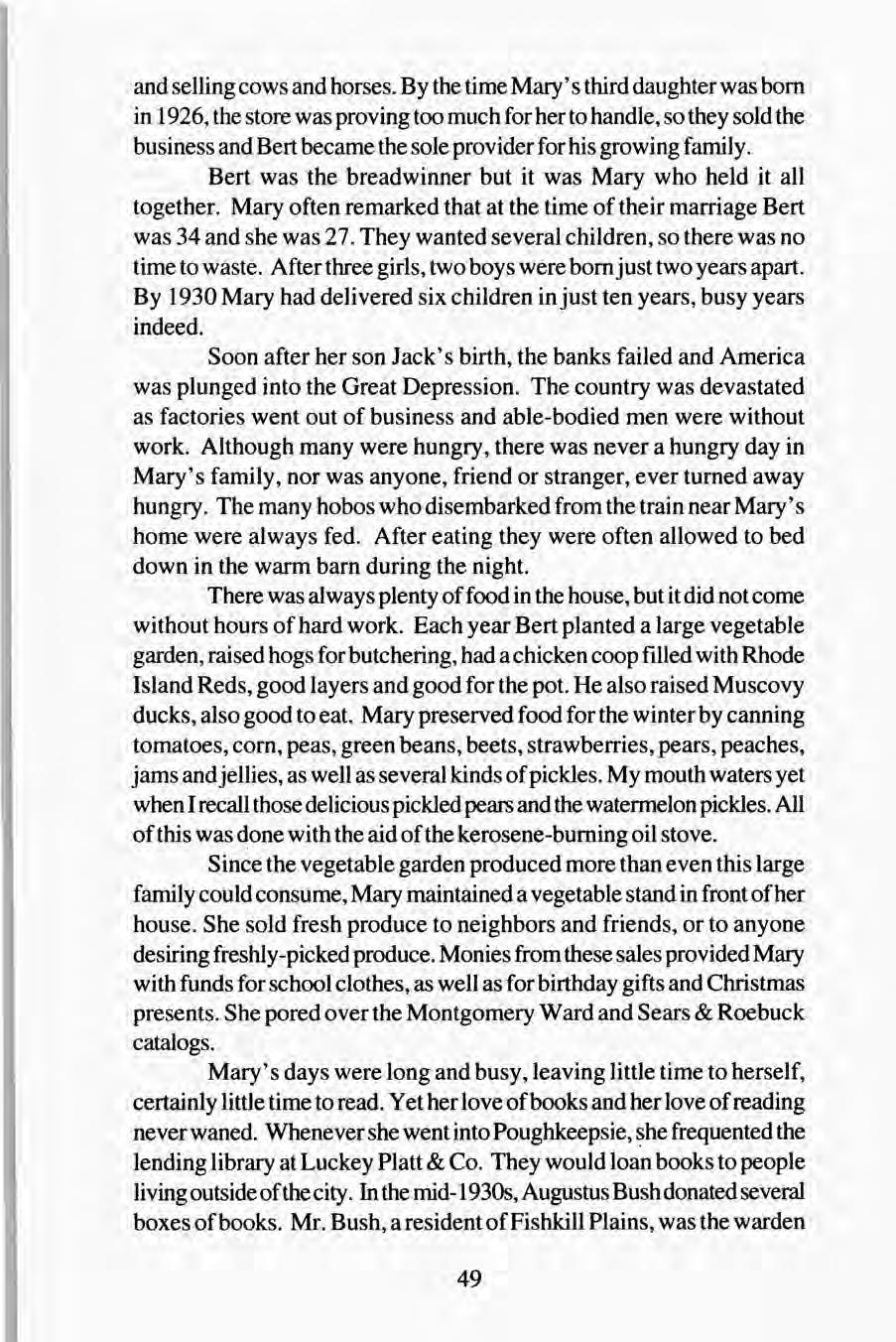
at Sing Sing Prison. His sister, Irene, had died and left the contents of her personal library. There were about l 00 volumes, consisting primarily of essays and poetry, but Mary could see these books as the seed for her longdreamed-oflibrary. Soon word got around that books were a welcome gift. Mary, with several of her neighbors, organized and opened the Community Library at Fishkill Plains. All of the work was done by volunteers, and money was raised through donations and from card parties held in homes around the community. It was not until the 1970s that the Town of East Fishkill budgeted $400 to be used by the library. Originally, the library was housed in the Wesleyan Methodist Church Chapel in Fishkill Plains and was open on Saturday afternoons and Wednesday afternoons and evenings. Some of the earliest roll-away book shelves were made by Nelson Sitzer. They were on rollers and could be pushed out of the way when the chapel was used for either religious services or other community gatherings. Mary ordered all of the books for the library, both new books and books on loan from the New York State Library in Albany. All were delivered to her home. She scanned each book before preparing it for the shelves. Her large family was a great help as she was forced to take books back and forth to the chapel. The mere fact that Mary was not a trained librarian never phased her. She was relentless in her pursuit of help and advice. Ruth Clow, librarian at Arlington High School, and the librarian at Adriance Memorial Library in Poughkeepsie were constant sources on which she relied. Early in the life of the library, Mary initiated the Children's Story Hour and the Summer Reading Program for Children. She encouraged young children to take books home so that parents or older siblings could read to them. Young students in high school and college often came to Mary with the subject of their research. She would select several books, flag them for reading, and reserve them for the student. This saved many hours and enabled the student to devote more time to reading and writing. Mary often served as ombudsman for the rank and file in her community. There was an African American man who had reached the age to collect his Social Security. He was required to produce a copy of his birth certificate, which he did not have. He could neither read nor write sufficiently to untangle the web of red tape in order to get his birth certificate. Mary wrote endless letters to authorities in the southemcommunity of his birth and finally obtained the required document. I recall too an old Italian immigrant who was barely able to speak English, let alone read or
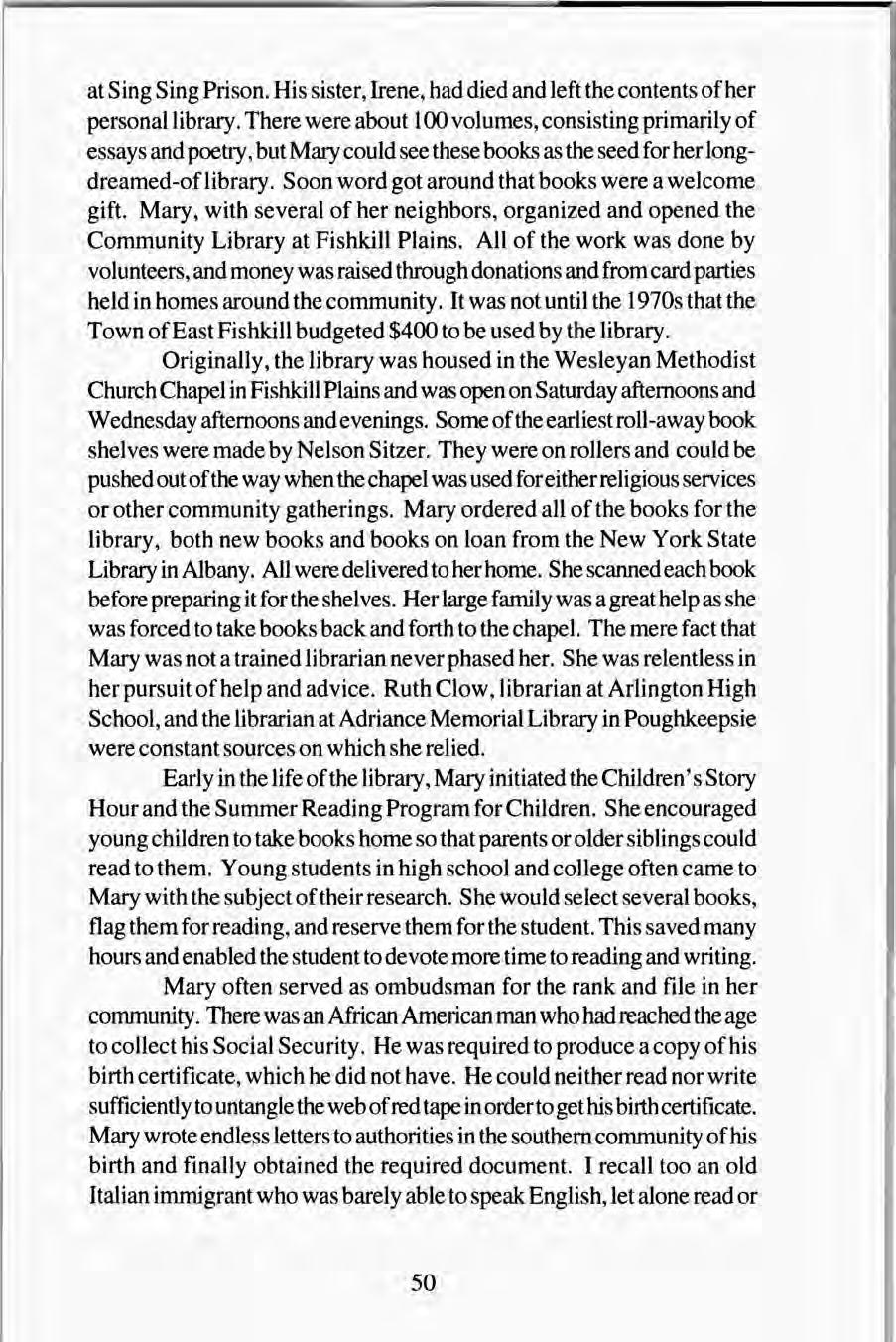
write. He had served in the Italian army and was eligible for a small pension but did not know how to get it. Mary spent two years unraveling the red tape until he was awarded his pension. She thoroughly enjoyed the challenge presented by such a task and derived great satisfaction in seeing people reap the benefits of her labor on their behalf. When April 15th rolled around each year, Mary stayed up late at night to fill out income tax returns for those neighbors who could not afford the services of an accountant. She also took the necessary test and became a Notary Public so that she could certify documents for her neighbors. In the early 1960s Mary was diagnosed with cervical cancer. The subsequent surgery and treatment kept her confined only briefly, but it gave her some time to read. Bert's stroke and illness deterred her for a while too. It was his death in 1964 that left a huge void in her life. Her responsibilities at the library took her attention away from her personal loss. As Mary's health began to fail, she found that she was unable to negotiate the steep stairs at the new library site in Gay head. She sorely missed working in the library, but those volunteers with whom she had worked for so many years made certain she had a constant supply of reading materials. Each week someone brought a large shopping bag of books for her to read. When her vision began to fail she was supplied with large print books. Her desire to read was insatiable. Mary was thrilled when plans were made to construct a new building for the library. It was to be built on land alongside the Town Office building on Rte. 376, land which had long before been designated for the library. One spring day Mary was on hand to help break ground for the new building. For months she watched as the building took shape, but she did not live to see the dedication. On July 3, 1988, in her ninety-fifth year, Mary died. I am sure the reader has come to the conclusion that Mary was my mother. Mary Lucy Ham Alley, who never failed to encourage my efforts, left her legacy. Her encouragement was verbal as well as by example, for she did not concede adversity. Rather, she worked, consulted, and found a way either to overcome orto circumvent obstacles. She never found hard work a deterrent nor did it discourage her. I am certain that there were many times when she was exhausted, yet found time and energy to help make hot chocolate and cookies for a group of hungry teenagers. I never knew Mom and Dad to take a vacation until long after all of their children had left home. They enjoyed their family, their friends, and their community. It is a distinct pleasure to visit the East Fishkill Community Library
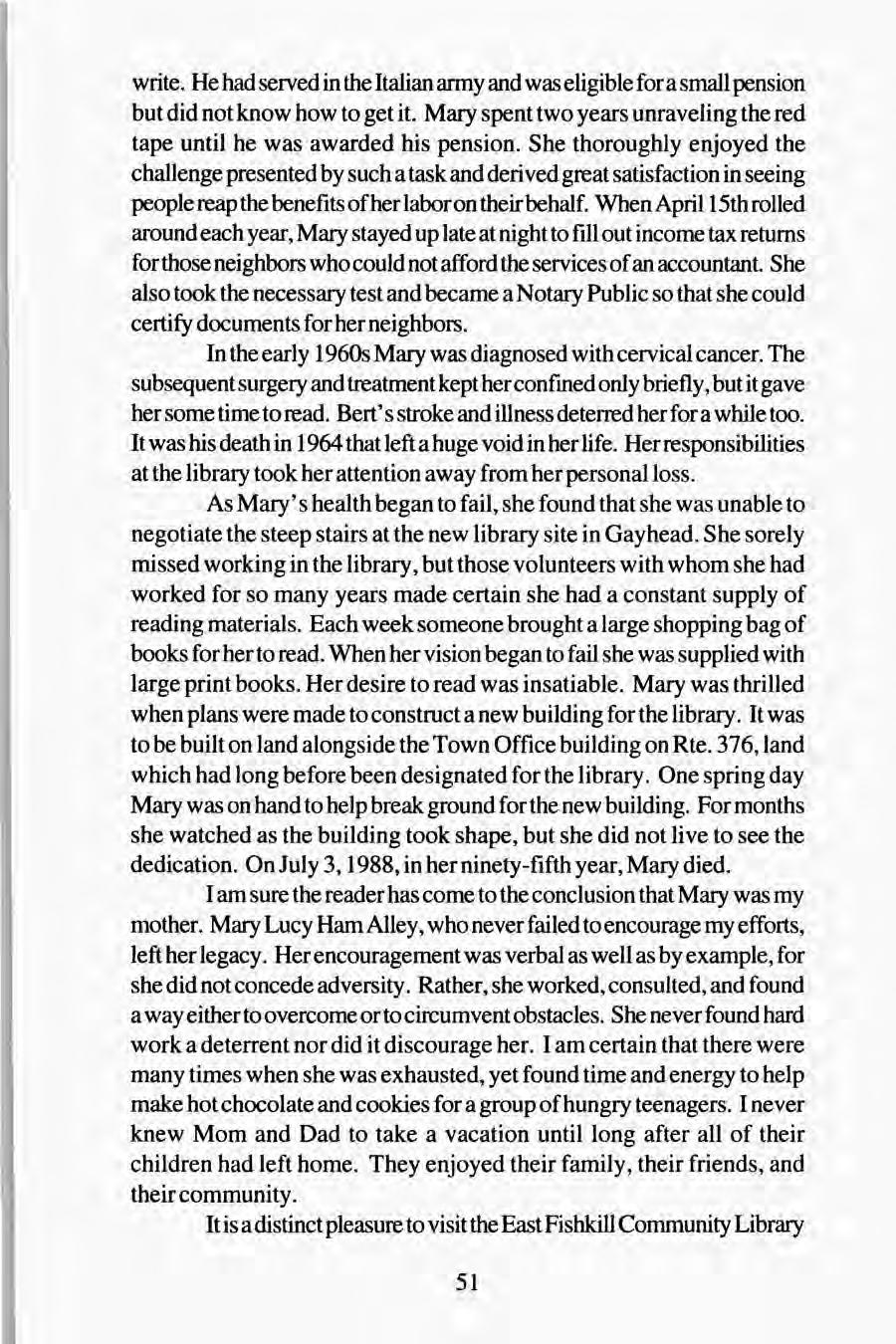
knowing that Mary's dream and her work toward that dream was a constant source of pride and pleasure to the people in her community. Her legacy lives for all to enjoy. She made a difference, not just in my life, but in the lives of many.



